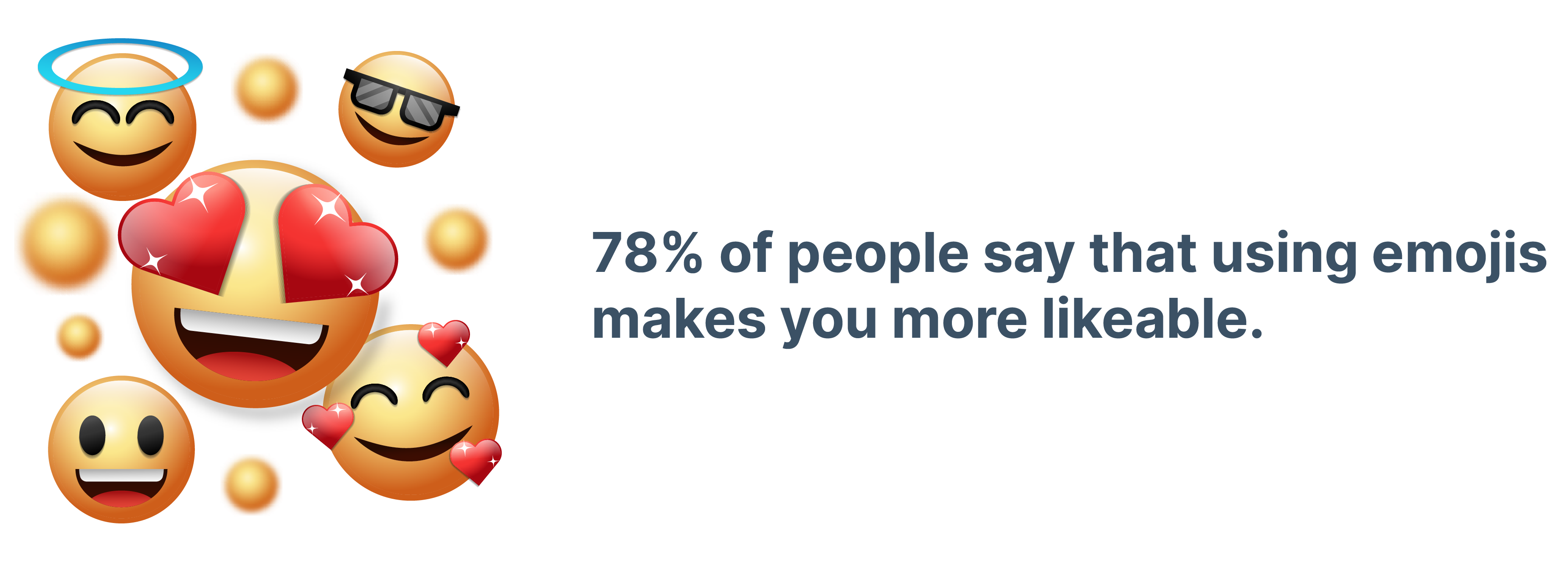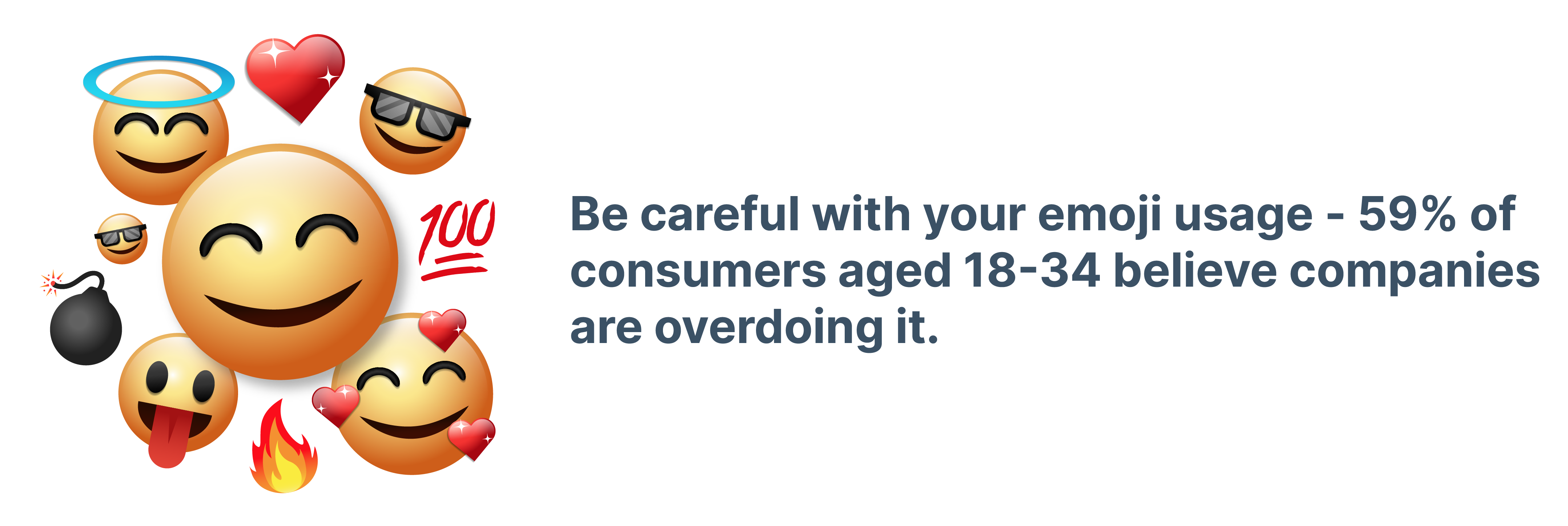How to Use Emojis in Your Marketing
While the majority of us use emojis in our everyday lives, some marketers are slightly more hesitant to use them in our marketing. But with 92% of the online population using emojis daily, it seems they are too popular to ignore. Everywhere you look online you see emojis - they are in our text messages, our emails, our push notifications and social posts.
Communicating online is very different than communicating in real life, and using an emoji gives a brand a personality, makes them more relatable and can sometimes convey certain messages and emotions (no pun intended) more effectively than using words alone. Nonverbal cues like body language and facial expressions provide emotion and understanding in real-life conversations, and using emojis online acts in a similar sense.
Benefits of using emojis
Gives your brand a personality & makes you relatable 💃
Every brand has something to say and adding emojis to your marketing is a great way to improve interactions with your customers. Emojis have become an integral part of our daily lives so communicating with your audience in the same way they communicate with each other will make your brand much more relatable. When you consider how you would speak to your customers in person, there is an equivalent emoji to match that. Speaking the same language as your audience means they are more likely to interact with you and helps to create a more lasting impact.

Source: PC Mag
Convey messages that words can’t 🙊
Sometimes, adding a simple emoji to a phrase can change the entire meaning. We’ve all heard the phrase ‘a picture is worth a thousand words’ and it’s safe to say that applies when using emojis. Adding one to your copy can make all the difference in the tone and sentiment you are trying to convey. In a similar way when adding an exclamation mark to your copy can convey excitement, adding an emoji can also portray this. While emojis can’t actually replace words themselves, they can work well together to add more depth and context to your message by providing a non-verbal emotion to your messaging. This is also particularly useful for social platforms where character count is limited, so adding an emoji will take up fewer characters than typing out another full sentence.
Boost engagement 📈
Why do you send emojis to your friends and family? Because they are fun and engaging! So it makes sense for marketers to use emojis to increase engagement and the statistics back this up:
- Instagram content with emojis sees an engagement increase of 48% (source).
- Comments and shares increase by about 33% when emojis are present (source).
- An emoji in the subject line of an email increases the open rate by 29% and the click-through rate by 28% (source).
- Push notifications with emojis are opened 85% more than those without (source).
With data like that, it’s difficult to resist using them in your online marketing campaigns.
Connect with wider audiences 👪
The way we communicate online now is completely different than how we did in previous eras, and using emojis helps your business speak the same language as your customers. This is particularly true for brands whose main target audience is Gen Z (anyone born between 1997-2012) who have grown up using emojis. Emojis are still relevant for millennials (1981-1996) however you need to be careful as different generations take different meanings from emojis (we will explain more on this later).
Considerations when using emojis
Love them, or hate them, emojis are here to stay. If you are going to use them in your marketing, it’s vital that you understand who your audience is so that you can make the best use of emojis. Here are a few considerations to keep in mind when you are using emojis in your communications:
Consider your audience
Emojis work extremely well for some industries and companies, but not as well for others. Consider your target audience and the brand image you want to convey. For example, while a fun and lighthearted fashion brand like ASOS can get away with using emojis often in their email marketing, an emoji in an email campaign for a more corporate business like a life insurance company is unlikely to resonate with the audience. Depending on the brand and the context, including emojis might actually make light of serious situations and make your brand appear insensitive. Imagine a customer is considering using a financial aid company only to be met with the money bags emoji 💰.
The same goes for companies that are targeting the baby boomer generation (born between 1946 and 1964). While many of them are probably highly technological and speak the emoji language, there are some who might not be as familiar. Using emojis in communications with them might create confusion if your audience don’t understand them, so in those situations, it might be best to avoid them altogether.

Source: Brandwatch
Find emojis that resonate with your brand
There are plenty of companies who are able to use one single emoji to highlight the product they are selling, for example, Domino's pizza can use the 🍕and McDonald’s can use 🍔 🍟. While there might not be an exact emoji that identifies the product you're selling, there are probably some emojis that you can use more often. For example, if your audience is predominantly beauty influences, then you could use emojis such as 💖💅💄✨ and if you are targeting sports fans, you could use emojis such as 💪⚾🏈👊💯. There might be some occasions where certain emojis are not relevant at all. Say for example you are a health food brand, you probably should stay away from using the fast food emojis like 🍩🍫🍟 as it might confuse your customers.
Emojis mean different things
With thousands of emojis to choose from, it’s possible you might choose one that has an entirely different meaning than what you intended it for, making you appear out of touch or at risk of offending your audience. If we take the peach emoji 🍑 as an example. If you are a peach juice company, then you have a challenge on your hands. While you may perceive it merely as an innocent healthy fruit, to many others, the peach emoji symbolises something else….we’ll let you take a guess what that is. The same goes for the aubergine emoji, but again we’ll let you come to your own conclusions on that one. If you are in any doubt about the meaning of an emoji, you can look it up on Emojipedia.
It’s also important to consider cultural differences. If you are appealing to a global audience, what might work for one country might not work for another. For example, the thumbs up emoji 👍in western cultures is a sign of approval, but is considered a rude gesture in Greece and the Middle east.
Don’t use too many
While it’s fun to use emojis, be careful to ensure you aren’t overdoing it. Having an unnecessary number of emojis will detract from your overall message as it might be difficult to actually decipher what you are trying to say. Moderation is key; if you have to ask yourself if you’ve included too many in your marketing campaign, then it’s likely you have. You don’t want your marketing to look like your cat has just walked across your keyboard and using too many will make your campaign appear forced, irritating or just confusing. You want your message to be clear and use emojis to draw attention or add some emotion to your messaging, not detract from it completely.

Source:YouGov
Experiment and test using your emojis
Like with any marketing tactic, you should test and analyse the performance of your content when using emojis. For example, you could A/B test an email campaign to see if open rates or click-through rates are higher when you use an emoji in the subject line. Likewise, you can test if your social posts receive more engagement when you use emojis compared to copy alone. During your analysing, it will be useful to try and determine:
- Which emojis are most effective with your audience?
- Which channels do your emojis work best on?
- Are there any emojis that don’t work at all for your brand?
Conclusion
Emojis are a simple and easy way to add personality to your messaging. Before throwing any and every emoji into your marketing and communications, ensure you know the true meaning and make sure it fits in with your brand, your industry and resonates with your target audience. Emojis are there to enhance your messaging and inject more emotion. Use them strategically and don’t forget on some occasions it’s okay to stick to what you know works best for your brand.
Share this
You May Also Like
These Related Stories

The 4 Common Mistakes When It Comes to Building Your Brand

10 Effective Marketing Strategies For Business Growth


